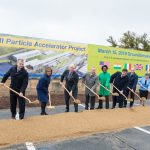From Kane Country Chronicle, March 15, 2019: Fermilab broke ground on a major new particle accelerator project on March 15 that will power cutting-edge physics experiments for many years to come. The new 700-foot-long linear accelerator, part of the laboratory’s Proton Improvement Plan II, will be the first such project built in the United States with significant contributions from international partners.
News
Swapan Chattopadhyay is one of 62 individuals elected this year as a Royal Society of Edinburgh fellow. Designated as a corresponding fellow, he has attained a high international standing in his discipline in the eyes of the RSE. Chattopadhyay researches the science and technology of particle and light beams and quantum sensors.
From UK Research & Innovation news, March 15, 2019: A major new physics facility at Fermilab is expected to have UK technology at its heart and lead to significant spin-off opportunities for UK companies.
The new PIP-II particle accelerator will power the Deep Underground Neutrino Experiment, which aims to address key questions about the origins and structure of the universe. The UK has committed £65 million investment to help build and operate DUNE, PIP-II and technology for the neutrino beam.
From Aurora Beacon-News, March 15, 2019: Fermilab broke ground on a project that takes it into the future as one of the world’s premier particle physics laboratories.
Scientist Jean-Paul Carneiro and collaborators in France are setting the stage for one of the world’s first autonomous particle accelerators. They will incorporate the world’s leading code for computing the dynamics of particle beams into a Fermilab prototype. Funding is provided through the FACCTS program, which fosters productive partnerships between Chicago-based and French researchers.
From Daily Herald, March 15, 2019: The ongoing attempt to fully understand our universe — how it started, what it’s made of, why it sticks together — is getting a new tool: a powerful linear particle accelerator at Fermilab.
Officials on Friday broke ground for the Proton Improvement Project-II, which officials said will power cutting-edge physics experiments for decades.
From NPR’s Here & Now, March 19, 2019: Fermilab is a global center for research into a tiny particle that could help answer some of the biggest questions in physics: the neutrino. Neutrinos have no electrical charge and almost no mass, but they’re everywhere. Fermilab Director Nigel Lockyer and Fermilab Deputy Chief Research Officer Bonnie Fleming talk about the Deep Underground Neutrino Experiment, visit the NOvA experiment and discuss the benefits of fundamental research.
A Swedish university tapped the founding director of CERN’s artist-in-residence program to curate a new art exhibit inspired by physics. The pieces are not literal translations of physics concepts to other media or illustrations of physics principles or phenomena. Physics was a spark for the artists, sometimes very clearly and sometimes more tangentially.
On March 15, Fermilab broke ground on PIP-II, a major new particle accelerator project at Fermilab. Dignitaries from the United States and international partners celebrated the start of the project at the groundbreaking ceremony. The PIP-II accelerator will power the long-term future of the laboratory’s research program, including the international Deep Underground Neutrino Experiment and a suite of on-site experiments.





